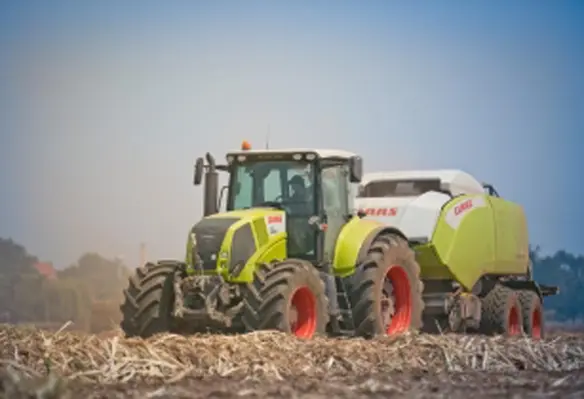It has been common practice to burn sugarcane fields before the harvest to allow faster cutting by hand, once the sharp leaves had been burned off
The process of manual harvesting can take up a long time and burning can make it faster. But the degree Brix and weight can decrease drastically within 48 hrs. Rising mechanisation with sugarcane harvesters already requires less pre-harvest burning; however, the leaves are still left on the field after the harvest as waste material. The fields need to be cleared quickly to start the next cropping cycle and thus burning was often the first choice, which brings along also heavy air pollution. Even though often referred to as sugarcane trash, the agricultural residue is valuable fuel for power plants to generate green energy.
Here, CLAAS offers with its QUADRANT square baler a practical solution to allow easier and faster collection of sugarcane leaves. This serves two key purposes: fulfilling the material demand of the power plants while clearing the fields for the next crop.
“Power plants can source sustainably material locally, farmers earn additional income from selling the sugarcane straw and above all, heavy air pollution caused by field burning can be avoided – it is a win-win situation for everyone,” said Jan-Klaus Tobias, managing director of the CLAAS Regional Centre South East Asia.
A while ago, Asia’s biggest sugar and bio-energy producer bought six CLAAS QUADRANT 4200 as an attempt to realise the goals set by the “Stop Burning” national programme in Thailand. The CLAAS QUADRANT has proven to be particularly efficient and reliable, which is why word of the CLAAS QUADRANT had spread fast throughout the agricultural industry. Farmers and contractors saw the benefits and have made use of the QUADRANT since then. This made the CLAAS QUADRANT square baler the most popular choice for baling biomass in tough conditions all over Thailand.
Collect sugarcane leaves with CLAAS QUADRANT 4200
The CLAAS QUADRANT 4200 is the most recent model for sugarcane leaves baling. Compared to small square balers, the QUADRANT’s main benefit is its higher throughput, wherefore the field can be cleaned faster allowing the sugarcane plants to start growing for the next harvest season earlier. Moreover, the high-density baling of sugarcane leaves provides significant savings on transport costs by utilising the full weight capacity during truck transport. The bale size of 1.2 m width, 0.7 m height and an adjustable bale length of up to 3 m ensures that local trucks can be loaded and unloaded quickly while constantly maintaining high stability during transport on the field and the road. All these benefits make the CLAAS QUADRANT 4200 the ideal choice for baling sugarcane leaves and other crop residue.
One distinctive feature of the CLAAS QUADRANT is that the baling pressure is controlled not just by the load on the mainframe, but also the twine tension. As the driver, you have a clear view of the load limits at all times, with no need to intervene directly. The automatic baling pressure system detects and adjusts the baling chamber accordingly to keep a consistent baling quality in all conditions.


In 1988, CLAAS introduced its first large square baler, the QUADRANT 1200, designed specifically for larger farms and contractors. It had a capacity of 30 tonnes of straw per hour, and produced straw bales of up to 360 kg in weight. With bale dimensions of 0.70 m high, 1.20 m wide and 1.00 to 2.50 m long, it corresponded exactly to the usual transport measurements in the European market, and was therefore ideal for loading bales onto trucks.
Eight years later, in 1996 CLAAS launched the QUADRANT 2200 in the market. With a completely new powertrain, new baler frame construction and the ultra-convenient CLAAS Control Terminal, that promoted even higher worker/hour profitability ratios for contracting operations. The updated version the QUADRANT 3400, introduced in 2006.
Currently, CLAAS provides three models of the QUADRANT. The QUADRANT 4200 can be viewed as the entry model with bale size of 1.2 x 0.7 meters, while the QUADRANT 5200 and 5300 come with a bale size of 1.20 x 0.90 meters. The special feature of the QUADRANT 4200 and 5200 is the all-new CLAAS high-power knotter. The new automatic pressure control system (APC) makes it even easier to operate these new balers at maximum power. The new QUADRANT also has a hydraulic feeder system and higher ram frequency. In 2017 CLAAS launched the QUADRANT 5300, with bale dimensions of 1.20 x 0.90 m.
Watch showcase here!
About CLAAS:
CLAAS (www.claas-group.com) is a family business founded in 1913 and is one of the world's leading manufacturers of agricultural engineering equipment. The company, with corporate headquarters in Harsewinkel, Germany, is the European market leader in combine harvesters. CLAAS is the world leader in another large product group, self-propelled forage harvesters. CLAAS is also a top performer in world-wide agricultural engineering with tractors, agricultural balers and green harvesting machinery. The CLAAS product portfolio also includes state-of-the-art farming information technology. CLAAS employs around 11,395 workers worldwide and reported a turnover of 4.04 billion euros in the financial year of 2020.





